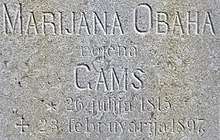Slovene months
Slovene months have standard modern names derived from Latin names, as in most European languages. There are also archaic Slovene month names, mostly of Slavic origin, which exist in both a standardized set as well as many variations.
Standard modern names

The standard modern Slovene month names are januar, februar, marec, april, maj, junij, julij, avgust, september, oktober, november, and december. When writing dates, they appear after the day and are often represented by Arabic numerals, and sometimes with Roman numerals (e.g., 19. 5. or 19. V. 'May 19th'). Older variants include januvarij 'January', februvarij 'February', and marcij 'March'.[1]
Standard archaic names
Many of the names in the standardized set of archaic Slovene month names first occur in the Škofja Loka manuscript, written in 1466 by Martin of Loka.[2]

- January prosinec '(sun) shining through';[3][4] modern Slovene januar
- February svečan perhaps 'dry' or 'cut' (influenced by svečnica 'Candlemas');[3][4] modern Slovene februar
- March sušec '(earth) dry (enough for cultivation)';[3][4] modern Slovene marec
- April mali traven 'small grass';[3][4] modern Slovene april
- May veliki traven 'large grass';[3][4] modern Slovene maj
- June rožnik 'flowers' (a translation of German Rosenmonat);[3][4] modern Slovene junij
- July mali srpan 'small sickle' (i.e., reaping);[3][4] modern Slovene julij
- August veliki srpan 'large sickle' (i.e., reaping);[3][4] modern Slovene avgust
- September kimavec 'nodding (fruit)';[4] modern Slovene september
- October vinotok 'wine flowing';[3][4] modern Slovene oktober
- November listopad 'falling leaves';[3][4] modern Slovene november
- December gruden 'biting (cold)'[3] or 'clumped (earth)';[4] modern Slovene december
Variant archaic month names
Multiple systems have been used in various Slovene-speaking regions, some of which were based on the names of saints (e.g., jurjevščak 'April', literally 'St. George's'), numbers (e.g., prvnik 'January', literally 'first'), or other features (e.g., vetrnik 'March', literally 'windy'). In the Prekmurje dialect of Slovene, the following system was attested: sečen 'January', süšec 'February', mali traven 'March', velki traven 'April', risalšček 'May', ivanšček 'June', jakopešček 'July', mešnjek 'August', mihalšček 'September', vsesvišček 'October', andrejšček 'November', božič 'December'.[5]
By month
- January
Additional names include brumen (< Italian bruma 'depth of winter'),[6] sečen[6] (related to suh 'dry' or from sek- 'cut'),[3] ledenec[6] and lednik[6] (< led 'ice'), mali božičnjak[6] and malobožičnjak[6] (< mali božič 'Epiphany'),[7] prozimec[6] (probably contamination of prosinec with zima 'winter'), prvnik[6] (< prvi 'first'), and zimec[6] (< zima 'winter').[7] The name prosinec, associated with millet bread and the act of asking for something, was first written in the Škofja Loka manuscript.[2]
- February
Additional names include sečan[3][6] and sečen[3][6] (both related to suh 'dry' or from sek- 'cut'),[3] and sečni mesec (< sek- 'cut').[3] The name svečan may relate to icicles or Candlemas.[8] This name originates from sičan,[9] written as svičan in the New Carniolan Almanac from 1775 and changed to its final form by Franc Metelko in his New Almanac from 1824.[8] The name was also spelled sečan, meaning "the month of cutting down of trees".[8] In 1848, a proposal was put forward in Kmetijske in rokodelske novice by the Slovene Society of Ljubljana to call this month talnik (related to ice melting), but it has not stuck. The idea was proposed by the priest and patriot Blaž Potočnik.[10] A name of February in Slovene was also vesnar, after the mythological character Vesna.[11]
- March
Additional names include brezen[6][12] and breznik[8] (both from breza 'birch'),[13] ebehtnik (< Middle High German ebennaht 'equinox'),[6] gregorščak[6] (< Gregor '(Saint) Gregory'), marcij,[6] postnik[6] (< post 'Lent'), traven[6] (< trava 'grass'), and tretnik[6] (< tretji 'third'). The name sušec was first written in the Škofja Loka manuscript.
- April
Additional names include brezen[6] (< breza 'birch')[13] and jurijevščak[6] (< Jurij '(Saint) George'). The name mali traven was first written in the Škofja Loka manuscript.[8]
- May
Additional names include cvetičnik[6] and cvetnar (both < cvet 'flower'), majnik,[3][6] mlečen[7] (< mleč 'chicory'),[7] risalščak[6] and rusalščak[6] (< risale/rusale 'Pentecost'),[7] rožni mesec (< roža 'flower'), and sviben[6] (< sviba '(flowering of) dogwood'). The name veliki traven was first written in the Škofja Loka manuscript.
- June
Additional names include bobov cvet[12] (literally, 'broad bean blossom') ivanjščak[6] and šentjanževec[6] (both referring to Saint John's Day), klasen[6] (< klas 'head of grain'), kresnik[6] (< kres 'bonfire', referring to Midsummer), prašnik[6] (literally, 'stamen'), rožencvet[7] and rožni cvet[6][12] (both 'flower blossom'), and rženi cvet[12] ('rye blossom').
- July
Additional names include jakobnik[6] and jakobščak[6] (both referring to Saint James's Day), pšeničnik[6] (< pšenica 'wheat'), and žetnik[6] (< žetev 'reaping').
- August
Additional names include kolovožnjak,[6] medmašnik,[6] mešnjak,[6] otavnik,[6][12] porcijunkula,[12] velikomašnjak,[6] and vršenj.[6]
- September
Additional names include jesenik,[6] jesenščak,[6] kozoprsk,[6] miholščak,[6] poberuh,[6][12] and šmihelščnik.[6]
- October
Additional names include kozoprsk,[6][12] listopad,[6] lukovščak,[6] moštnik,[6] obročnik,[6] repar,[6] repnik,[6] vinec,[6] and vinščak.[6][12]
- November
Additional names include andrejščak,[6] gnilolist,[6] listognoj,[6][12] martinščak,[6] vsesvečnjak,[6] and vsesvečak.[6]
- December
Additional names include kolednjak[6] and veliki božičnjak[6] (< božič 'Christmas').[7]
See also
- Croatian months
- Czech months
- Macedonian months
- Slavic calendar
References
- Gradišnik, A. (October 1, 1883). "Čas". Učiteljski tovariš. 23 (19): 299.
- Stabej, Jože (1966). "Ob petstoletnici škofjeloškega zapisa slovenskih imen za mesece" [On the 500th Anniversary of the Škofja Loka Recording of Slovene Month Names]. Loški razgledi (in Slovenian). Muzejsko društvo Škofja Loka [Museum Society of Škofja Loka]. 13. ISSN 0459-8210.
- Snoj, Marko. 2003. Slovenski etimološki slovar. 2nd edition. Ljubljana: Modrijan.
- Vaštíková, Zuzana. 2012. Slovinské a české pranostiky. Brno: Masarykova univerzita, Filozofická fakulta, Ústav slavistiky.
- Kalendar najsvetetjšeja srca Jezušovoga. 1925. 22: 3–8.
- Pleteršnik, Maks. 1894/95. Slovensko-nemški slovar. Ljubljana: Knjezoškofijstvo.
- Reindl, Donald F. 1995. Evidence for the Germanic Origins of Some Slovene Month Names. Slovene Studies 15: 169–178.
- "Koledar prireditev v letu 2007 in druge informacije občine Dobrova–Polhov Gradec" [The Calendar of Events and Other Information of the Municipality of Dobrova–Polhov Gradec] (PDF) (in Slovenian). Municipality of Dobrova-Polhov Gradec. 2006. Cite journal requires
|journal=(help) - Vasmer, Max, ed. (1972). "Zeitschrift für slavische Philologie". 36–37. Markert&Petters: 115. Cite journal requires
|journal=(help) - "Slovenska imena mesecev" [Slovene Names of Months]. Kmetijske in rokodelske novice. 6 (37). 13 September 1848.
- Bogataj, Janez (2005). "Slovenska mitologija – Vesna" [Slovene Mythology – Vesna]. Bilten; poštne znamke [Bulletin: Postage Stamps] (in Slovenian, English, and German) (56). ISSN 1318-6280.
- Bajec, Anton et al. 2000. Slovar slovenskega knjižnega jezika. Ljubljana: DZS.
- Bezlaj, France (ed.). 1977–2007. Etimološki slovar slovenskega jezika. 5 volumes. Ljubljana: SAZU.
External links
- http://projetbabel.org/forum/viewtopic.php?t=7222 A comprehensive table of Slavic and Baltic month names, explanation in French.